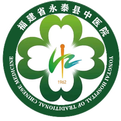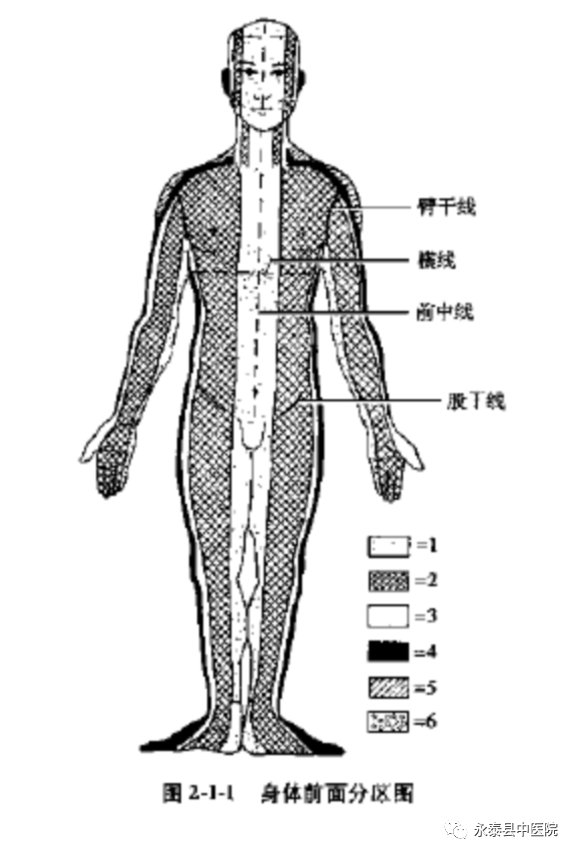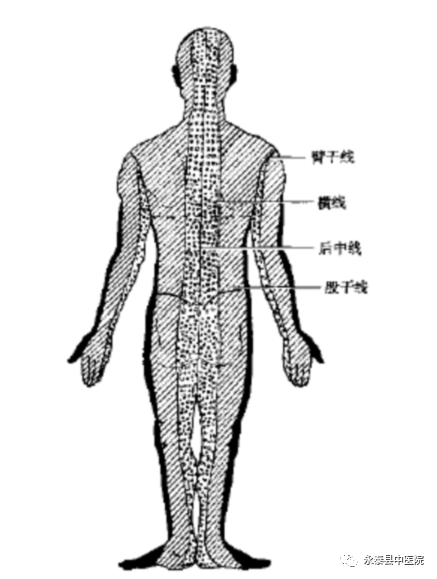
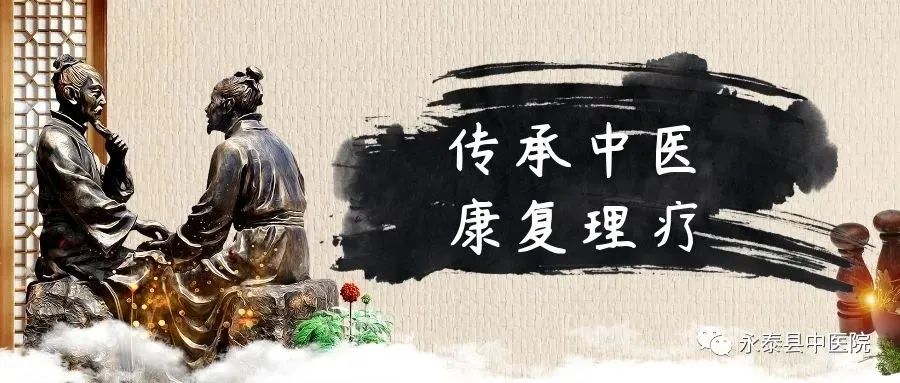
The wrist and ankle acupuncture technique involves needling the wrist and ankle areas of the body to treat diseases. The theoretical basis is to associate the internal organs with different areas of the body surface, and then correspond different body surface areas with the wrist and ankle regions. By stimulating specific areas of the wrist and ankle, the aim is to treat corresponding internal organ diseases. Clinically, it is commonly used to treat various pain syndromes, neurological disorders, and internal medicine diseases.
I. Common Instruments and Basic Operation Methods
(1) Commonly Used Needles
Primarily using 25mm or 40mm long filiform needles.
(2) Point Selection Method
1.Regional Localization and Point Selection
(1) Human Body Regional Localization (see Figure 1, Figure 2)
This needling method divides the surface of the human body into six regions, named numerically 1-6. Each region is associated with the internal organs it covers. The specific divisions are as follows:
Region 1: The area on both sides of the midline of the body, including the forehead, eyes, nose, tongue, lips, anterior teeth, throat, trachea, esophagus, heart, upper abdomen, navel, lower abdomen, and perineum.
Region 2: The sides of the front of the body, including the temples, cheeks, posterior teeth, submandibular area, thyroid, supraclavicular fossa, breasts, lungs, liver, gallbladder, and lateral abdomen.
Region 3: The outer edge of the front of the body (i.e., the outer edge of Region 2), which is narrower, including the head and face along the anterior edge of the auricle, and the chest and abdomen along a vertical line down from the anterior axillary line.
Region 4: The boundary area between the front and back of the body, including the area directly below the ear to the vertical line down from the ear lobe, the edge of the trapezius muscle, and the vertical area from the apex of the axilla to the anterior superior iliac spine.
Region 5: The sides of the back of the body, corresponding to the front Regions 2, including the posterior temporal area, lateral neck, scapular area, both sides of the trunk, and the lateral aspect of the lower limbs.
Region 6: The area on both sides of the midline of the back of the body, corresponding to the front Region 1, including the posterior head, occipital region, spinal area, sacrococcygeal area, and anus.
|
|
|
(2) Wrist and Ankle Sub-Region Localization (see Figure 3, Figure 4)Determine stimulation points at the wrist and ankle respectively. According to the body’s regional division, use numbers 1-6 for corresponding naming to determine treatment points. Based on the position of the treatment points at the wrist and ankle joints, the treatment points at the wrist are named Upper 1 to Upper 6, and those at the ankle are named Lower 1 to Lower 6. Thus, each limb can have 6 treatment points, totaling 12 acupuncture points throughout the body, with each point having a left and right side, resulting in 24 treatment points.
Upper 1 Region: Located between the ulnar edge on the little finger side and the ulnar flexor tendon. The method is: the practitioner uses one thumb to touch the ulnar edge on the little finger side, then gently pushes forward, with the point located in the depression next to the tendon. This point is commonly used.
Upper 2 Region: Located centrally on the palmar side of the wrist, between the palmaris longus tendon and the radial flexor tendon, corresponding to the Neiguan (Pericardium 6) point. Care should be taken to avoid blood vessels during needling.Upper 3 Region: Located on the radial side, two transverse finger widths above the wrist crease, at the edge of the radius. It is situated between the radius and the radial artery.Upper 4 Region: With the palm facing inward, located two transverse finger widths above the radial edge on the thumb side, at the midpoint between the inner and outer edges of the radius.Upper 5 Region: Located centrally on the dorsal side of the wrist, between the radius and the ulna, similar to the external Guān (Triple Energizer 5) point of the traditional meridian system.Upper 6 Region: Located on the dorsal side of the wrist on the little finger side, two transverse finger widths above the wrist crease.Lower 1 Region: Located on the inner edge of the Achilles tendon, equivalent to three cun (traditional measurement) above the Taixi (Kidney 3) point.Lower 2 Region: Located above the ankle, centrally on the inner side of the lower leg, near the posterior edge of the tibia.Lower 3 Region: Located above the ankle, about one cun inward from the anterior edge of the tibia.Lower 4 Region: Located above the ankle, at the midpoint between the anterior crest of the tibia and the anterior edge of the fibula.Lower 5 Region: Located above the ankle, centrally on the outer side of the lower leg, near the posterior edge of the fibula.Lower 6 Region: Located above the ankle, on the posterior side of the lower leg near the outer edge of the Achilles tendon.
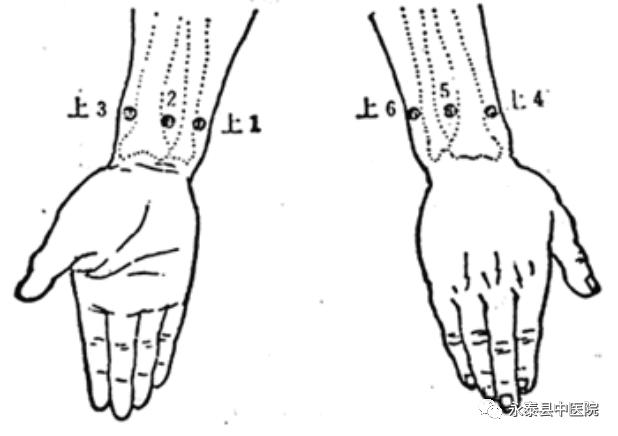
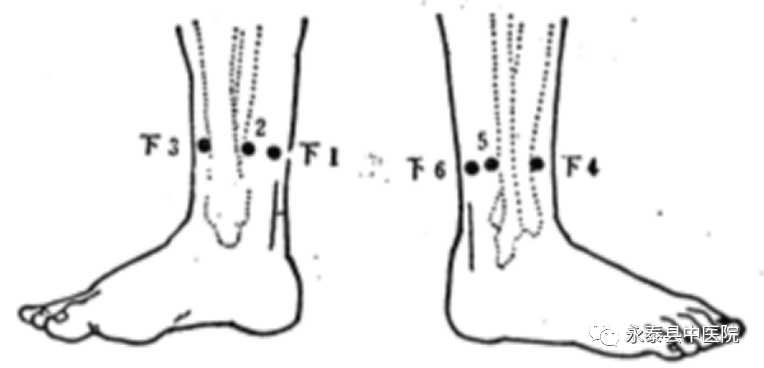
(3) Point Selection Method
Point selection principle: Select points on the same side and in the same region as the disease for treatment. Specifically, for diseases above the diaphragm, select wrist points; for diseases below the diaphragm, select ankle points. If the disease spans both upper and lower regions, both upper and lower points can be selected; for diseases along the midline, select Upper 1 and Lower 1 points.
Point combination method: Points can be combined based on the directional area of the affected region. For example, in cases of hemiplegia, Upper 5 and Lower 4 can be selected. For diseases with difficult-to-determine areas that cross regions, such as insomnia, night sweats, and generalized itching, points on both sides can be combined; for the aforementioned conditions, both sides’ Upper 1 points can be selected.
(2) Basic Operation Methods
1. Needle Insertion: Standard disinfection is performed. The practitioner stabilizes the upper part of the acupuncture point with one hand, pulling the skin taut with the thumb and index finger, while the other hand holds the needle with the thumb below and the index and middle fingers above, inserting the needle at a 30° angle quickly into the subcutaneous layer. The needle should advance along the longitudinal axis of the limb under the dermis, with a soft sensation under the needle being ideal. If the patient feels soreness, numbness, swelling, pain, or heaviness, it indicates that the needle has penetrated too deeply into the fascia, and the needle should be withdrawn to a more superficial position. Initially, there may be slight pain upon needle insertion, but the pain should immediately disappear once the needle is in place. To ensure the needle remains subcutaneous, after the needle tip enters the skin, release the holding fingers so that the needle naturally falls and stays close to the skin surface. The direction of needle insertion should be towards the affected area; if the condition is in the fingers or toes, the needle tip should point downwards; if in the head, chest, or lower back, the needle tip should point upwards. The depth of insertion should ideally expose 2mm of the needle body; when needling Upper 1 or Lower 6 points, the needle should be parallel to the edges of the wrist or ankle.
2. Retaining the Needle: Generally, the needle is retained for 30 minutes. For painful conditions or certain chronic diseases, the retention time may be extended appropriately.
II. Common Diseases Treated with Wrist and Ankle Acupuncture
(1) Common Cold (Upper Respiratory Infection)
The common cold is caused by external pathogens of wind-cold or wind-heat invading the lung defense, with clinical manifestations including nasal congestion, runny nose, cough, chills, fever, and body aches. The condition can be categorized into different patterns such as wind-cold, wind-heat, and damp-heat.
[Treatment Principle] Disperse the exterior and expel pathogens.
[Operation Steps] Use Upper 1 as the main point, and combine with Upper 2, Upper 5, Upper 4, etc., based on symptoms. Use a 40mm filiform needle, with the needle tip pointing upwards, and insert horizontally under the skin. Perform once daily until recovery.
(2) Dizziness (Cervical Vertigo)
This condition is characterized by dizziness and a spinning sensation, often caused by wind-yang disturbance, phlegm-stasis obstructing the brain, leading to insufficient nourishment of the brain.
[Treatment Principle] Pacify the liver and subdue yang, nourish liver and kidney.
[Operation Steps] Use Upper 1 as the main point, combined with Upper 3. Use a 40mm filiform needle, with the needle tip pointing upwards, and insert horizontally under the skin. Perform 3-5 times a week, with one month as a treatment course.
(3) Leukorrhea (Bacterial Vaginitis)
This condition is characterized by excessive leukorrhea, which may be thick and turbid or clear and watery, with a foul odor. It is often due to instability of the Chong and Ren vessels, leading to dampness and turbid fluids descending.
[Treatment Principle] Transform dampness and benefit the Ren vessel.
[Operation Steps] Use Lower 1 as the main point, combined with Lower 2. Use a 50mm filiform needle, with the needle tip pointing upwards, and insert horizontally under the skin. Perform 3 times a week, with one month as a treatment course.
III. Contraindications
1. Patients who are overly fatigued, hungry, or mentally stressed should not be needled immediately; they should recover first before treatment.
2. Patients with weak constitutions should not receive strong stimulation.
3. Patients with spontaneous bleeding tendencies or persistent bleeding due to injury should not be needled.
4. Needling should not be performed on areas of the skin with ulcers or infections.
5. Other contraindications are the same as those for standard acupuncture.
IV. Precautions
1. If there are large blood vessels under the skin at the acupuncture point, or if there is significant pain upon needle insertion, the insertion point should be adjusted. When moving the insertion point, it should follow the principle of not deviating from the line, meaning it should be moved along the longitudinal direction and not sideways.
2. If fainting occurs during needling, the needle should be quickly removed, and the patient should be laid flat.
3. This needling method does not emphasize the sensation of needling. If there is an electric shock sensation, significant pain, or if the needle tip touches hard tissue, the needle should be withdrawn.

Previous Articles:
[Traditional Chinese Medicine Techniques 01] Acupuncture Techniques – Filiform Needles
[Traditional Chinese Medicine Techniques 02] Acupuncture Techniques – Scalp Acupuncture
[Traditional Chinese Medicine Techniques 03] Acupuncture Techniques – Auricular Acupuncture

